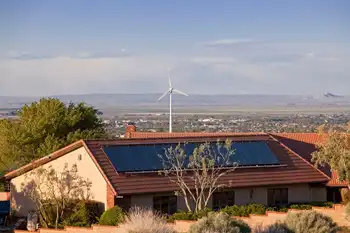Transmission line hearing generates praise, concerns
GREAT FALLS, MONTANA - A public hearing on what would be the first merchant transmission line between Canada and the United States drew 100 residents to Great Falls, with economic development officials and elected officials singing its praises and farmers raising concerns.
The $150 million Montana Alberta Tie Line would stretch 230 miles — 129 of them in Montana — between Great Falls and Lethbridge, Alberta. It's being proposed by Montana Alberta Tie Ltd., a wholly owned subsidiary of Toronto-based Tonbridge Power Inc.
Three developers who are planning wind farms along the route have purchased shipping capacity on the line.
"The environmental impacts are minimal and the economic benefits are great," said Cheryl Curry of the Pondera Regional Port Authority.
Sen. Jerry Black, R-Shelby, told officials with the state Department of Environmental Quality and the U.S. Department of Energy, who must issue a permit for the line, that northcentral Montanans have endured extreme drought, declining school enrollment and declining tax bases. To say that the majority of his constituents enthusiastically support MATL, he said, is an understatement.
The three-hour public hearing at the Great Falls Civic Center was the first of three that are scheduled to take public comment on a draft environmental impact statement on the project.
In the first two hours in Great Falls, 18 people testified, with 15 in favor and three raising concerns.
The 230-kilovolt MATL line already has been permitted by Canada's National Energy Board. It has received conditional approval from the Alberta Energy and Utilities Board.
In the U.S., state and federal officials released an environmental study in March 2007 but decided to do additional work after the public raised concerns. A draft environmental impact statement was released last month.
Katrina Martin of Dutton testified that the routes should follow field lines, rather than cut diagonally. Single poles should be use, rather than H-frames, on cropland and land that's set aside for the Conservation Reserve Program, she said.
"The requests of these farmers are not unreasonable," she said.
Martin said she is for the project. But she prefers an alternative proposal that regulators came up with. That line, as opposed to the company's preferred alternative, is longer and has fewer impacts on landowners.
Jerry McRae, who farms near Dutton, said MATL is offering a one-time payment of $500 for each pole on property owners' land, plus yearly payments of $59.08 per pole annually to offset the hardship of farming around them. McRae said was "completely unacceptable," because the cost is $250 a pole.
To ease the impact on farmers, Bob Williams, vice president of MATL's regulatory division, said single poles are now planned along 53 miles where the transmission line crosses diagonally. Originally, 25 miles of single poles were planned.
Tony Como, director of permitting and citing for the DOE, said it's possible a decision to permit the project could be out by May or June.
Como said the U.S. Department of Defense and the State Department must sign off because the transmission crosses an international border.
For the state to approve the project, the DEQ's Tom Ring said it must find that the line has a minimal impact on the environment and is consistent with regional plans for expansion of the electric grid, while serving the public's interest.
The state has only denied one transmission project in the past.
Como said MATL would be the first merchant line between Canada and the United States. There is one small line connecting Mexico and the U.S.
Traditionally, transmission was constructed by regulated utilities, such as the old Montana Power Co.
In the case of a merchant line, a company builds the transmission, and separate power generator entities pay to use it.
Deregulation of the power industry, which split up generation, marketing and transmission of power into separate companies, "created a market place for independently owned transmission projects," Como said.
MATL's Williams said he hopes to break ground later this year. The company already has invested $10 million in a transformer, which is being manufactured in Germany.
Besides connecting separate electric grids in Alberta and the United States, Williams said MATL would allow for the development of wind-powered electricity in Montana that might otherwise be stranded because there is not enough existing transmission to get the power to market.
Williams said connecting the two electric grids is "like having a spare tire" because it will lead to better reliability of electricity as well.
While the three wind developers have secured the line's primary capacity, secondary space could be sold to other coal, natural gas and hydrogenerated power generators.
Shippers will make the decision on what to do with their power, but Williams said much of it is likely to end up in larger markets in Alberta or elsewhere in the United States.
Related News

Opponent of Site C dam sharing concerns with northerners
VANCOUVER - One of the leading opponents of the Site C dam in northeastern B.C. is sharing her concerns with northerners this week.
Proponents of the Site C dam say it will be a cost-effective source of clean electricity that will be able to produce enough energy to power the equivalent of 450,000 homes per year in B.C. But a number of Indigenous groups and environmentalists are against the project.
Wendy Holm is an economist and agronomist who did an environmental assessment of the dam focusing on its potential impacts on agriculture.
On Tuesday she spoke at a town hall presentation in Fort…




